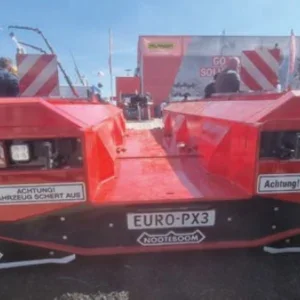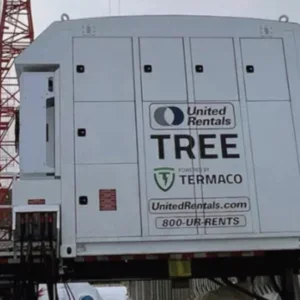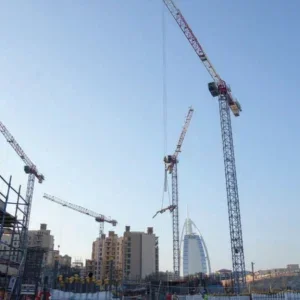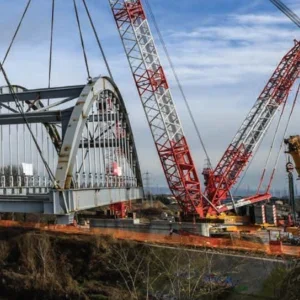It’s okay to do things slightly differently in the Netherlands, so long as it’s practical. That’s why grown men can ride a tricycle and not be run-over at every reasonable opportunity. And that’s why you can put tower cranes on trucks or tracks and provide a viable alternative for lifting.
Mobile tower cranes are not just a viable alternative, they are a booming success in the Netherlands. The two local manufacturers of truck-mounted self-erecting tower cranes are Spierings Kranen and Gis Munsters. Neither can keep up with a growing appetite for their products.
Spierings is moving into a new factory next year in order to expand production. Leo Spierings set up the company in 1987. He is not surprised by the success of what he calls mobile folding cranes. “Companies here like this type of crane. They are more precise and quicker. In an hour they can do 20% to 30% more work.” Spierings says the cranes are competing against all-terrains and truck cranes. On sites such as apartment and office block construction, where the working radius is small, mobile folding towers have an advantage of being able to work in confined spaces as they do not need the up and over outreach telescopic cranes require. With a travel speed of 80km/h and a loading of 12t per axle they can also travel on the open road, which means they can be at three or four sites a day, Spierings says. The towers can be erected at the touch of a button.
In its first two years Spierings Kranen serviced Munsters, Liebherr, Potain and other top-slewing tower cranes. In 1989, after a request from a client, it built and delivered its first truck-mounted self-erecting tower crane. Orders followed quickly and its 50th unit was delivered in September 1995. This was followed by the 100th unit in May 1997. The company now claims to have produced 180 cranes as well as maintaining a strong servicing business.
Spierings Kranen manufactures the chassis and towers for its cranes. It has developed three, four and five-axle models (SK 365, SK 477, SK 598), all with 1.7t capacities at maximum jib lengths of 30m, 38m and 48m respectively. All have 30° luffable booms and operator cabins at the top of the tower. This gives the operator a bird’s eye view of the lifts, which is a crucial advantage over AT and truck cranes, he says.
Once Spierings Kranen is in its new 45,000m2 facility next year it will begin production of a new four-axle model. This will have a 40m jib with a capacity of 2.1t at maximum reach and 8t at 12.6m. Despite only being in the prototype stage Spierings claims there are already 22 orders for the new four-axle. Maarten Verschoor of Verschoor Kranen in the Netherlands says he has ordered three units, along with two units of both the three and five-axle Spierings. This goes with the seven Spierings cranes Verschoor already has.
Several Dutch rental companies claim they are getting better returns on truck mounted self-erectors than for ATs. Part of the reason for this is the speed with which they can be set up and dismantled and part is that the locally made product is cheaper to buy and maintain than high-tech, imported ATs.
Jelle Jan Burggraaff, managing director of crane hire company BKF, says his mobile self-erecting tower cranes are always out on jobs and will easily clock up 1,700 hours of rental this year. Of the 55 cranes in his fleet eight are Spierings Kranen mobile towers. He has two more on order. Another crane rental company, Nederhoff, expresses the same sentiments. Its managing director, Ron Nederhoff, says the locally-made mobile towers are particularly popular with builders.
The challenge now for Spierings will be to expand the popularity of its cranes beyond the Dutch borders. With annual production capacity set to increase to around 70 units, once the current waiting list is whittled down, supply is eventually going to outstrip demand. The dilemma is how fast do you push into new markets when you are struggling to meet demand at home? Leo Spierings is keen to step up promotion of his product abroad because it will take time for the markets to come to terms with the mobile self-erecting towers, possibly even two to three years. “After all,” he says, “it is a new way of lifting.” He is considering exhibiting at Intermat in Paris next year and he has previously exhibited at Bauma.
The Germans have had a taste of the cranes already. There are three Spierings there, including one with rental company Weisbauer. Apart from Germany, Spierings considers the most likely markets to be England and Scandinavia. The company already has an agent in Denmark.
Gis Munsters
Gis Munsters has a year-long waiting list for its mobile tower cranes. That is the price of success. Managing director Barend Heystek says the company would like to expand its production but the shortage of labour in Holland means it is unable to do so. Gis Munsters produces 20 units a year, but would like to take that up to 30 or 35.
Heystek is also aware that Holland is a limited market. Even producing 20 to 30 cranes a year Gis Munsters will need to develop export markets in the next two to three years as demand in Holland starts to flatten.
“I think export to Germany is the most logical [move]. However, there will be interest all over the world,” Heystek says.
Export success will take time. Even the local market took time to warm to the mobile tower cranes, but as the product has become more sophisticated over the last 10 years, and more user friendly, it has become very popular, he says. “They have become much further developed and can work as easily as a hydraulic crane. The advantage on site is that the [driver] is looking down at the work which makes it more precise.” Gis Munsters has two models. These are a three-axle carrier with a 30m jib and 1.5t capacity at maximum reach and a four-axle carrier fitted with a Peiner crane, which has a 42m jib and lifts 1.5t at maximum reach. In March or April next year the company hopes to launch a three-axle model with 2t capacity at 35m and 6t at 13m.
Liebherr is planning its own truck-mounted tower crane, the MK80, to be launched next year. Not surprisingly, Liebherr is launching the MK80 in response to a request from a Dutch rental firm which has ordered two.
Crawler towers
However, the next battle for Gis Munsters and Spierings Kranen may still be on home soil. Both are planning crawler-mounted versions of their folding tower cranes. And they will have more competition than with their truck-mounted versions.
Spierings Kranen will begin work on its crawler tower when it moves into its new factory. The crawler version will be able to be erected and dismantled in one hour and will lift 5t at maximum reach of 35m, with a 16t maximum capacity, Leo Spierings says. The crane will be bottom slewing and will be able to travel under load. It will take two trucks to transport. The market will be the rental companies which want to take it to a site for anything from two weeks or longer, says Leo Spierings. Gis Munsters plans to release its new crawler in March/April. The base will be built in Italy and then completed at Gis Munsters’ factory in Hoogstraat, south west of Eindhoven.
Another Dutch company, Kranenbouw has formed a joint venture to manufacture Liebherr tower cranes mounted on Manitowoc crawlers. The first Superlift, as the crane is called, has just begun work in Katwijk (see Crane mounts crawlers, below).
However, Belgian crane rental and manufacturing company Arcomet has been making crawler mounted self-erecting tower cranes for some time. The company plans to build a new assembly plant on its Paal site next year and a new range of self-erecting towers will be launched. The A 45B will have a 2.1t capacity at 45m and initially will be a tower only. A crawler version will follow shortly after, according to Arcomet.






